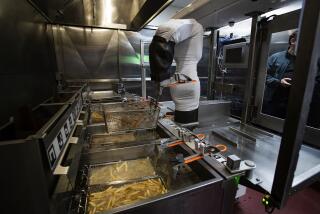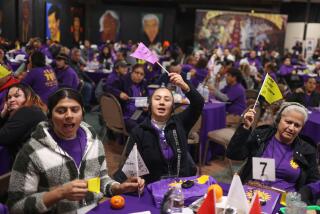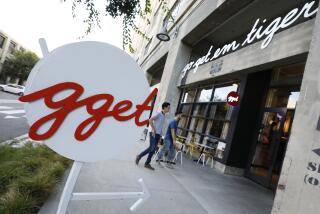THE SOUTHERN CALIFORNIA JOB MARKET: WHERE...
Tom Kemmer spent 20 years at the General Motors plant in Van Nuys, welding body panels and chassis, fixing windshield wipers and radios.
He helped assemble hundreds of thousands of cars, but when GM shut the place in August, Kemmer’s $17-an-hour job was gone.
Now his savings rest on how many meatball, turkey and pastrami sandwiches he can hustle out of a Subway fast-food franchise he’s about to open in Canoga Park.
Kemmer will spend about $80,000 to get the shop running--$10,000 in franchise fees, the rest for the lease, remodeling, furniture and equipment. He has a contractor’s license, so he will save some money by building the counter tops and installing the ceiling fans, light sockets and plumbing fixtures.
Kemmer, 43, has plenty to worry about, but at least he knows where his future is. A year ago, he “didn’t know what to do,” he says. “Trying to get a job that pays, you’ve got to have a college education.”
GM’s layoff package was generous: Most of the 2,600 Van Nuys workers would get 85% of their pay for up to a year, plus a chance to go to school.
Some GM workers learned how to repair VCRs, but they may make just $8 an hour.
Kemmer wanted more. Then last spring, his brother bought a Subway store and, after GM closed up, Tom spent a month working at his brother’s place. He decided that the work was “nice and clean. And I could take pride in it.”
So Kemmer started looking for a site. He liked a busy shopping center near his home with a Ralphs, a McDonald’s, a drugstore and lots of parking space next to a big intersection. One day Kemmer saw an empty store where a Penguin’s frozen-yogurt shop had failed. That would be the place.
How to pay for it? Last year, Kemmer and his wife refinanced the mortgage on the four-bedroom home they’d lived in for 13 years and took $62,000 in equity out of it. That, plus another credit line--using their home as collateral--became part of Kemmer’s capital.
The old Penguin’s place still has to be overhauled and the Subway decor--heavy on wood veneer, plastic plants, turn-of-the-century subway drawings, and yellow booths--has to go in. Once the shop opens, Kemmer figures that his weekly break-even point will be more than $3,000 in sales. Of that, 8% will go to Subway in royalties, another 2.5% for company advertising. Still, Kemmer believes that his monthly profit might reach $5,000.
If so, that would beat what he made at GM. But now, it all rests on him--and the competition.
Although his store is near a busy intersection, his place is somewhat out of view, behind El Pollo Loco, McDonald’s and a doughnut shop.
And just 1.1 miles away is another Subway shop; Kemmer knows the precise distance because he clocked it. He argues that the other Subway shop is in a strip mall, and so his place will draw more traffic.
Maybe. But in the industry, some complain that Subway overloads areas with franchises, leaving some store owners with wafer-thin profits. The Subway chain has 7,400 stores worldwide--and 216 in Los Angeles County.
Kemmer concedes that his wife, who works for a computer company, has wondered if all will go as planned.
Certainly Kemmer needn’t look far for reminders of failure. Over his front door the yellow paint is chipped where the Penguin’s sign was, the outline of the letters still visible. If one business failed here, why can’t Kemmer’s?
“I do worry,” he admits.
Tom Kemmer Age: 43 Experience: welder, auto assembly plant Capital invested: $80,000
More to Read
Inside the business of entertainment
The Wide Shot brings you news, analysis and insights on everything from streaming wars to production — and what it all means for the future.
You may occasionally receive promotional content from the Los Angeles Times.











